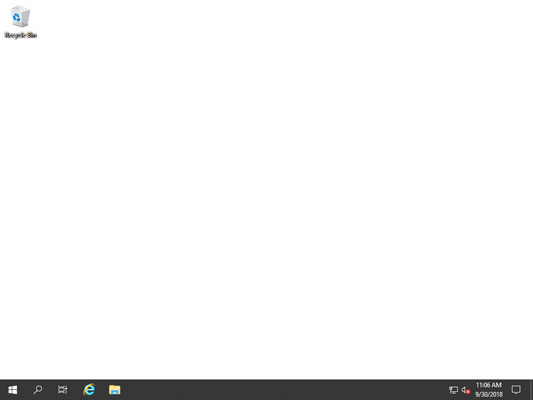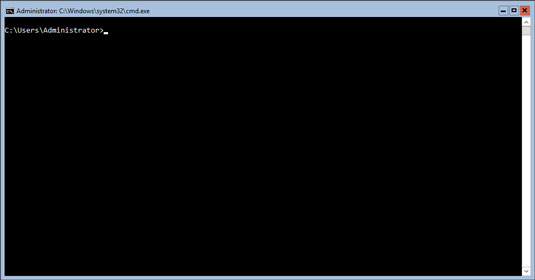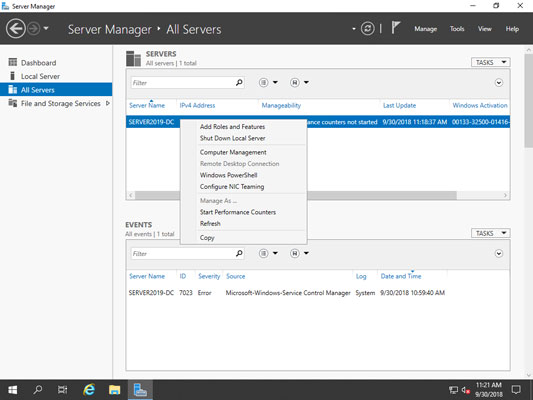Desktop Experience
Desktop Experience is what you would consider to be the standard graphical user interface (GUI) that you may have used in previous versions of the Windows Server operating systems. It allows you to interact with the system with buttons and menus rather than through the command line. Server with Desktop Experience can be managed through Group Policy if attached to an Active Directory domain, and workgroup (non-domain) servers can be managed via local Group Policy.Desktop Experience tends to be the easier form of server installation and administration for beginning system administrators, but I highly recommend that you don’t rely on the GUI (shown in the figure). Become a PowerShell ninja instead! PowerShell is a very versatile language and can be used on a variety of systems, including some of the newer versions of Linux.
 Server with Desktop Experience.
Server with Desktop Experience.Server Core
Server Core (shown in the following figure) provides a much simpler interface if you connect to the console. You’re greeted by a somewhat familiar-looking command window that prompts you for your username and password. After you’ve logged in, you get the traditional C:\ prompt. You can run the traditional command-line commands from this console. Alternatively, by typing powershell.exe, you can launch a PowerShell window. Initial configuration is done with the sconfig utility, though it could be done through a PowerShell script or PowerShell Desired State Configuration (DSC). This experience can be managed through Group Policy if attached to an Active Directory domain or through local Group Policy if they’re workstation servers. Server Core.
Server Core.Nano
Nano provides an even simpler interface and a much more limited console, which is referred to as the Recovery Console. It isn’t available through the regular installer on the disc; instead, you have to “build” the image from files available on the disc. Nano has a much smaller footprint, both in disk and compute needs than Desktop Experience or Server Core. Because it has a smaller overall footprint, the attack surface is also reduced. Windows Server Nano 2019 is available only as a container base operating system image, and can only be run as a container on a container host.Note: You won’t really see Nano discussed in depth anywhere in this book because you’re far more likely to encounter the Desktop Experience or Server Core installations of Windows Server 2019.
Nano can’t be managed through Group Policy. You need to use PowerShell DSC instead if you want to manage Nano at scale. You may be asking why you would even use Nano when it’s such a limited version of the operating system. If you need to run container workloads that use .NET, Nano is an excellent candidate because it has been optimized to run .NET Core applications.
What Server Manager has to offer
When you first install Windows Server 2019 and you log in, the first screen that you’re greeted with is Server Manager (see the following figure). This screen gives you a central area to do all the configuration tasks you need to do on your server. It presents a handy menu to manage all the roles and features installed on your server as well. Server Manager.
Server Manager.Server Manager will allow you to manage remote servers, not just the local server. The remote servers need to be added to Server Manager before they can be managed, and some firewall ports may need to be opened to allow full functionality. After remote servers are added, you can run PowerShell against them and perform basic management tasks like shutting down, connecting via Remote Desktop Protocol (RDP), and so on. You can manage up to 100 remote servers with Server Manager. This number may be lower depending on what you’re running on the manage servers. If you’re running large workloads, then you may not be able to manage as many.
Server Manager can be used to manage the same operating system it’s installed on, as well as operating systems that are older than what is installed. It can’t manage the operating system on a server that is running a newer version of the operating system. For example, a server running Server Manager on Server 2012 R2 can’t manage a server running Windows Server 2016.
The figure shows some of the options available through the Server Manager menu. You may notice that Remote Desktop Connection is grayed out. This is because I was logged on the server that is in the window. Managing servers with Server Manager.
Managing servers with Server Manager.Here’s a list of some of the more commonly used features of Server Manager:
- Managing local and remote servers
- Managing roles and features on servers (To install or remove roles and features, the target system must be running at least Server 2012)
- Starting management tools like Windows PowerShell and MMC snap-ins
- Reviewing events, performance data, and results from the Best Practices Analyzer





